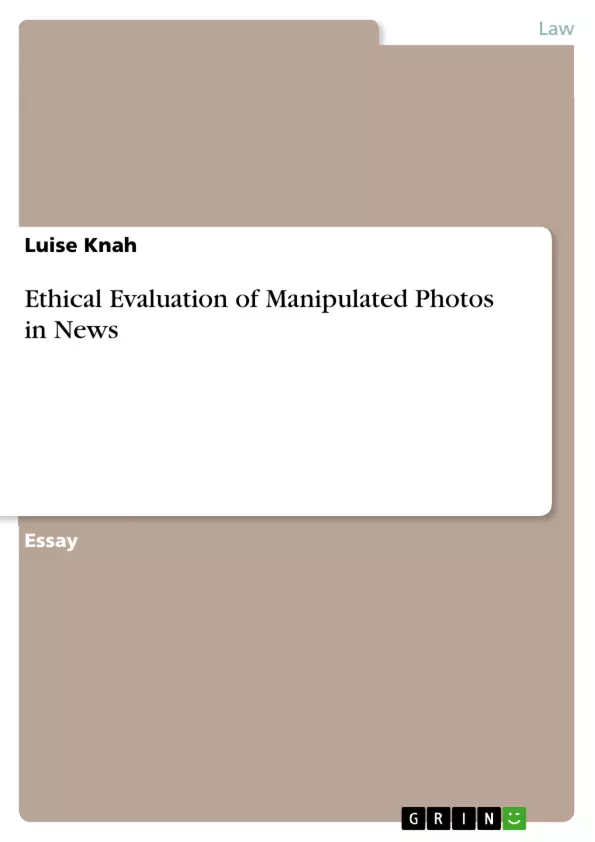Historically, photographs are considered to deliver an accurate description of a shown event
as a ‘snapshot of time’. 1 With digital technology and image alteration programs like
Photoshop, this natural assumption has changed. Nowadays, every amateur is able to
manipulate pictures and a lot of publications use the technology to enhance their photos.
The question if photo manipulation is ethical in general is very broad and depends on the
situation. The ethical evaluation in this essay focuses on the problematic application in news
rooms. Even the slightest alterations can be considered as a violation of the truthful reportage
of an event that has taken place. News organisations act by self-regulating policies and are
not restricted by law regarding photo manipulation, including those in Australia. The industry
standard is to allow the enhancement of photographs for clarity and definition, but altering
the composition is to be frowned upon.2 Journalists have to be cautious about their actions,
because faked pictures jeopardize their own reputation as well as the credibility of the
publication. Cropping out irrelevant details is a legitimate and well-known practise not only
in news, but also in fashion, advertisement or even personal photography. The challenge is to
evaluate the shift in the perception of the viewer.
Inhaltsverzeichnis (Table of Contents)
- Ethical Evaluation of Manipulated Photos in News
- Three Categories of Image Manipulation
- Aesthetical Alteration
- Ethical Grey Zone
- Unethical Alteration
- The Ethical Judgement of Photo Manipulation
- The Question of Labelling
- Misinformation and the 'Truth' in Pictures
- Photo Manipulation Beyond Retouching: The 'Authentic' Image
- Conclusion
Zielsetzung und Themenschwerpunkte (Objectives and Key Themes)
This essay explores the ethical implications of manipulated photographs in news reporting, focusing on the problematic use of image alteration software like Photoshop in newsrooms. It examines the different categories of image manipulation and analyzes the ethical boundaries surrounding them. The essay also discusses the challenges of defining and identifying ethically problematic manipulations, considering various factors like context, intent, and the impact on the viewer's perception.
- Ethical evaluation of photo manipulation in news
- Categorizing types of image manipulation
- Determining ethical boundaries in photo editing
- The impact of manipulated images on the public
- The role of journalistic ethics and professional codes
Zusammenfassung der Kapitel (Chapter Summaries)
The essay begins by introducing the historical perception of photographs as accurate representations of reality and how digital technology has challenged this assumption. The author highlights the increasing prevalence of photo manipulation in news publications and the ethical concerns surrounding it. The essay then discusses three categories of image manipulation: aesthetical alteration, ethical grey zone, and unethical alteration, providing examples to illustrate each category.
The essay continues to explore the challenges in evaluating the ethicality of photo manipulation. It examines the thin line between ethical alterations, such as enhancing clarity, and unethical alterations, which might deliberately mislead viewers. The essay also explores the concept of journalistic ethics and professional codes, highlighting the importance of maintaining the integrity of photographic content and context.
The author then delves into the debate surrounding labeling manipulated photographs. While some argue for transparency and labeling to inform readers, others believe it could undermine the credibility of news publications. The essay further discusses the impact of misinformation on society, emphasizing the importance of accurate information for informed public opinion.
The essay concludes by broadening the discussion beyond the technical aspects of photo manipulation, acknowledging the potential for manipulation even before the editing process. It highlights the subjective nature of image selection, framing, and composition, suggesting that every step of the photographic process can influence the viewer's interpretation. The author stresses the need for critical analysis and skepticism, especially in the digital age of readily available image alteration tools.
Schlüsselwörter (Keywords)
The primary focus of this essay is on the ethical considerations surrounding the use of manipulated photographs in news reporting. Key terms include photo manipulation, Photoshop, image alteration, journalistic ethics, codes of ethics, ethical grey zone, aesthetical alteration, unethical alteration, misinformation, public perception, and the impact of image manipulation on society.
- Citation du texte
- Luise Knah (Auteur), 2011, Ethical Evaluation of Manipulated Photos in News , Munich, GRIN Verlag, https://www.grin.com/document/179245



